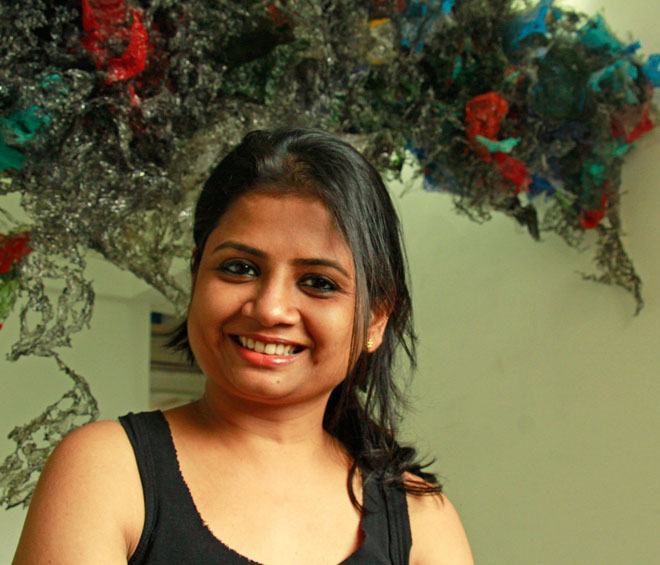
by SKYE ARUNDHATI THOMAS
Aaditi Joshi (b1980) really likes plastic. She has, for more than a decade now, worked with the ubiquitous and polarising material. She is drawn to its beauty, she tells me, to its transparency and its quicksilver nature: it is a material that is prone to forming accidental and surprising shapes. She makes sculptures that join together hundreds of thin plastic bags and sheets into billowing, multicoloured shapes. She also paints small canvases in acrylic or oil, and the subject of these paintings are her plastic sculptures; small plastic torsos of dolls and figurines; or her own body – entirely covered in large sheets of plastic.
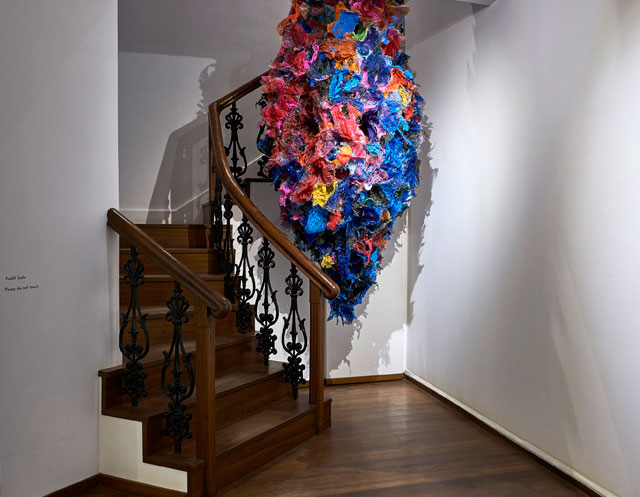
Aaditi Joshi. Untitled, 2018. Site-specific installation, fused plastic bags, acrylic colour, wood armature, 216 x 48 x 40 in. Photo: Ashish Chandra. Courtesy TARQ and the artist.
It is not an easy material to work with, or to show: the first response to a gathering of plastic bags and sheets is rarely a discussion of its aesthetic potential, as much as a sad reminder of the material that has clogged up our oceans and rivers, as well as the innards of countless animals, birds and fish. But to Joshi, who has spent her whole life in Mumbai, it is a constant source of inspiration, especially as it is one of the most omnipresent elements on the streets where she lives.
Mumbai, as it stands today, was created by an ambitious 18th-century colonial engineering project that unified seven islands by reclaiming land from the Arabian Sea. At the time of this land-reclamation project, canals and waterways were constructed at strategic intervals to allow for drainage of the heavy rainfall the city receives every year during the monsoon. With the mass production of plastic – and the hyper-industrialisation of the city over the past couple of decades – these canals and waterways, so integral to the safety of the city, have filled up with a huge amount of trash, of which plastic is the primary component.
After the overwhelming monsoon floods of 2005, Joshi walked through the city as cleanups were in progress – in places, entire streets were covered in plastic and trash. After she saw the city consumed by the material that she had chosen to be her primary protagonist, her sculptural forms grew more ambitious and resilient: her work unravels from the walls and on to the surrounding spaces of the sites in which it is installed. Joshi’s sculptures obstruct passageways and take over entire rooms, almost always overwhelming the space they occupy. She is primarily concerned with the ornamental and figurative nature of the material, and is keen to highlight its formal properties through her work.
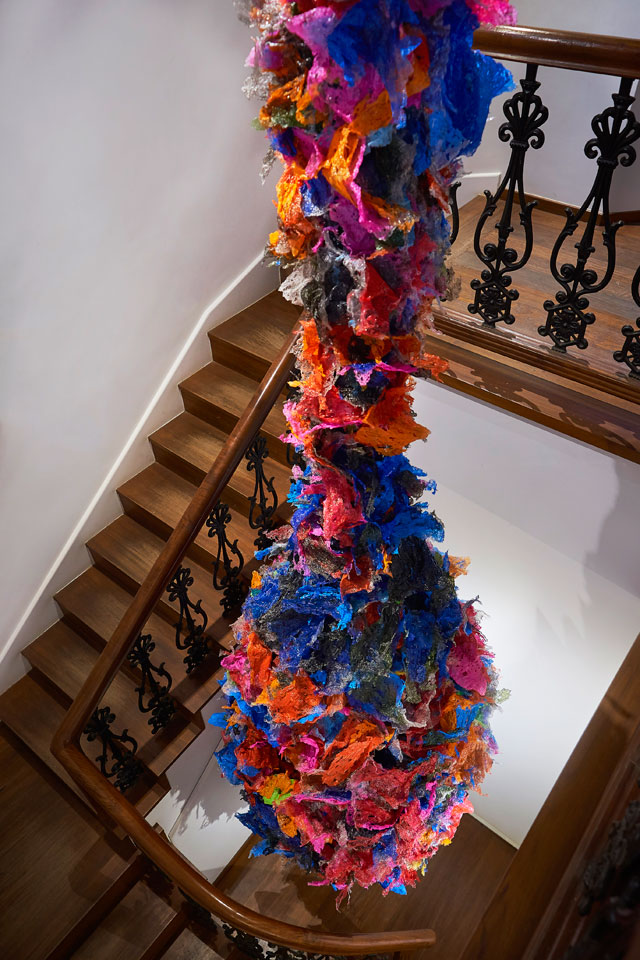
Aaditi Joshi. Untitled, 2018. Site-specific installation, fused plastic bags, acrylic colour, wood armature, 216 x 48 x 40 in. Photo: Ashish Chandra. Courtesy TARQ and the artist.
It is difficult to see the beauty in plastic, particularly when my imagination is unable to divorce the material from an apocalyptic vision of where it almost always ends up: choking our environment and its inhabitants. However, in her literal approach to pulling the material into the gallery space, Joshi is not using the plastic as a metaphor or allegory. The work forces the viewer to confront its ubiquity, and how we are all deeply complicit in allowing it to take over our planet.
Skye Arundhati Thomas: You work primarily with thin, single-use plastic bags and sheets. You take something that is considered as throwaway by most people, and treat it with great care and attention. Why this material?
Aaditi Joshi: I am attracted to plastic because of its transparent surface and the way in which it takes shape in accidental ways. I have lived in Mumbai all my life, where it is quite common to see piles of trash at the corners of the street. As I walk around the city, what catches my eye are the colourful pieces of plastic in the trash. These pieces of plastic create their own forms. For instance, bags are submerged in puddles of dirty water or oil. The forms created by the meeting of oil, water and plastic, and the way that the light hits them, are interesting to me, and I am haunted by them. These are completely abstract forms – trash exists in a very free state, and there is a freedom of form to it. As I work on my sculptures, photographs and paintings, I keep these visions of plastic’s oiliness and its floating quality at the back of my mind.
I knew right away that I wanted to paint the surface and its transparencies, and this might have to do with my formal training as painter at the Raheja School of Art in Mumbai. Painting allows me to deliver texture to the way in which light translates on to the plastic surface. Sometimes I install small LEDs into the sculptures to highlight this interplay of light, and the bags look as though they have been crystallised. The lighting is often as important as the work itself, because the surface glitters and has a natural tendency to catch and reflect light. I have also, over time and after much trial and error, developed a technique of heating the superficial surface of the plastic with candles to produce a netted, knit-like structure. I used to stitch the bags together, but they would easily fall apart, so heating the material is also the way I join smaller clusters of bags and sheets together to create larger forms.
Over time, my use of size and proportion has become more ambitious. For my first solo show, Zero Opacity, at the Jehangir Art Gallery in Mumbai in 2005, the works on display were very small, maybe only seven or eight inches [18 or 20cm] at their longest. At the time, I was working with a different kind of plastic, which was much thicker. The plastic that I use now is very thin (it is typically used to make magazine sleeves); it is the thinnest available on the market and is as fragile as Sellotape.
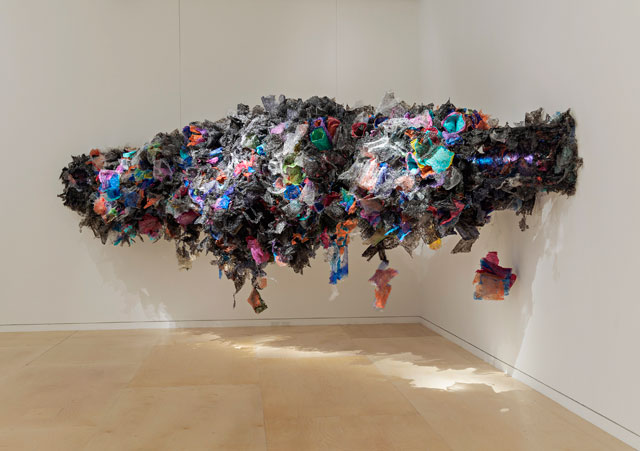
Aaditi Joshi. Untitled, 2016. Site-specific installation, fused plastic bags, acrylic paint, LED lights, wood armature, 288 x 78 x 108 in. Courtesy Museum of Fine Arts, Boston.
SAT: The transformation of plastic is important to you: first, in the way it turns soft and loose when sunk in an oil slick, or in cloudy street water. You further transform it yourself by the manner in which you paint it, or the knitted texture it develops when you heat it using a candle. In some of your photography work, you have also thrown water and paint over the material. Could you describe your various processes and use of mediums?
AJ: The visual transformation of the plastic bag is very important. Preparing the bags is like preparing a surface on which to work. It is not as though I work with a ready canvas or paper, but, instead, I have to craft my surface by manipulating the plastic in different ways. When the bags are ready, it is as though my whole medium is ready, not just the material. Only when I developed the technique of heating plastic with candles did I started making dimensional forms, so it has always been a process of experimentation. It is also a process that requires a lot of patience, but I find that enjoyable. I sketch a lot, and once I have come up with a loose form for a sculpture, I construct a simple wooden armature, drape the bags and sheets over it, and start working in small sections, or “clusters”. An important part of the technique is a process of “tearing”: I have to pull the clusters apart in order to reach the final form. Sometimes, the final work is just half the size of what I began with, as a lot gets lost while tearing through, and that’s part of the practice – tearing to get to the final sculpture.
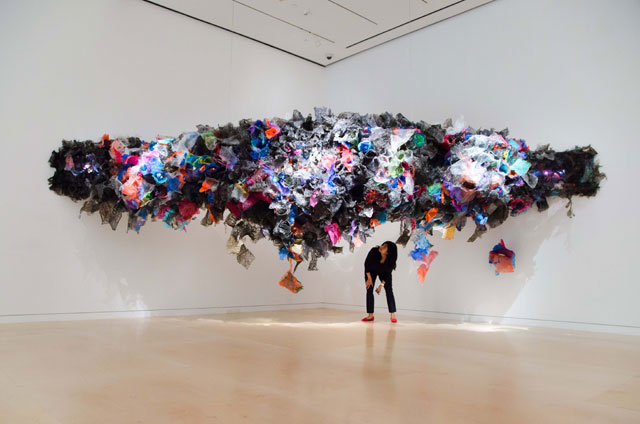
Aaditi Joshi. Untitled, 2016. Site-specific installation, fused plastic bags, acrylic paint, LED lights, wood armature, 288 x 78 x 108 in. Courtesy Museum of Fine Arts, Boston.
I begin a work by gathering bags that are completely transparent and I apply acrylic colour on to their insides. I never mix colours, although I work with many colours at the same time. I am interested in keeping each colour separate and individual. The bags are held over a candle and only very slightly heated, so when the tip of the candle flame touches the immediate surface of the plastic, it produces the netted form. This happens because the surface begins to break open, which happens very quickly, so I have to be steady and careful. Sometimes, I will go over a single bag several times. I also make completely “candle-black” bags, which is a natural black I create by gently going over the entire bag.
I still paint on canvas, make videos and take photographs, but in all the different mediums, I still keep plastic as my protagonist. My practice is not static, as the material invites me to test it through different techniques. When I work at a very large scale, it is difficult to preserve the shape. So I dismantle the work and keep its clusters with me. I often reuse these clusters for new work. For my photography works, I like to treat these clusters either by pouring water and paint over them, or pulling them apart to see what new forms I can make for a kind of still-life tableau. I also extensively photograph while making the sculptural work, so the material is photographed at different stages of the process. Often, I find that the photographs of these “in-between” stages are more beautiful than the final sculptures.
.jpg)
Aaditi Joshi. Untitled, 2016 (detail). Site-specific installation, fused plastic bags, acrylic paint, LED lights, wood armature, 288 x 78 x 108 in. Photo: Smita Jacob /Hogger & Co.
SAT: Shortly after your first solo show in 2005, Maharashtra was hit by one of the most brutal floods in recent history. You have said before that this had a huge impact on your work. Perhaps you could speak about your experience?
AJ: That year, plastic was on everybody’s minds, and on everyone’s doorsteps. Even after the floods left us, the panic and fear remained, and so did the plastic. Plastic and trash had choked our drainpipes and the floodwater could not drain out of the city as easily as it is supposed to. The water had brought trash on to the streets and there were large heaps of plastic every few feet. It was probably the first time I realised the enormity of the impact of what plastic does to the fabric of our social life. I was shocked to learn of how much plastic is consumed by animals, particularly the cows and dogs that wander city streets, not to mention the damage that plastic does to the marine environment. All I could picture was how animals and plants were getting suffocated everyday by the material that I had chosen as my medium. This is why I made the video Suffocation (2008), which is accompanied by a series of pastels on paper, in which my own head is wrapped in, quite literally, breathtaking plastic.
I think, after the floods, I started looking for the evidence of trash around me more than I did before. It was my visual material, a kind of mood-board. Discarded plastic does not just lie on the floor: it hangs on pipes; floats in the breeze or in stagnant water; it is scattered over fields and lawns. It is not as though trash is separated from our lived life in the city, it is very much present in our everyday visual setting. I visit the clogged canals and waterways often, taking photographs of the different stages of their obstruction. The interlocking and free-flowing nature of the trash that collects there is hugely referenced in my work.
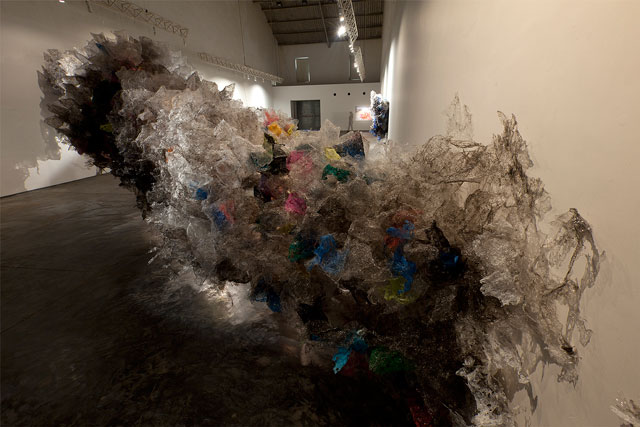
Aaditi Joshi. Untitled VII, 2011. Site-specific installation, fused plastic bags, acrylic paint, LED lights, wood armature, 432 x 94 x 110 in. Photo: David Desouza. Courtesy Gallery Maskara, Mumbai.
SAT: The dry pastel paintings that form a part of the Suffocation series are quite beautiful. There is a poetry to them, and yet the scenes of asphyxiation are uncomfortable and jarring. There is a similar quality to the sculptural work: the installations that overwhelm the viewer with bags of plastic are visually interesting, but are difficult to confront. What is the relationship between the two sentiments?
AJ: I think am always switching between beauty and trash, with the aim of expressing this tension and relationship in my own language. In my show Zero Opacity, I had small canvases on which I had painted my sculptural forms. My first instinct is always to paint, and to paint beautifully, but with time I have evolved from this impulse. I am more focused on the sculptures now, and on making them larger and messier. Since I start the sculptural works by first painting the plastic surface, the painterly quality remains. In the paintings of the series Suffocation, I have covered myself on the canvas with huge plastic bags, and I did this because I wanted to express myself in a situation of suffocation. To make this work, I actually did cover myself in plastic, got myself photographed, and used these photographs as to help work on the paintings. I don't want to lose the connection between the plastic and myself, and between the sculptures and myself.
When I was making the small acrylic and oil-on-canvas works, I used to paint still-life plastic torsos of dolls and small figurines, all of which are readily available at the street markets. As I have moved to the sculptural objects, I want to be closer to the material, and express the beautiful side of plastic. This is important to me, and is the main intention of my work. The scale at which I work now was first developed in 2011 for the solo show New Works, at Gallery Maskara in Mumbai. I was nervous about moving to such a large scale – the work was 36ft long, a far cry from my initial seven or eight-inch works.
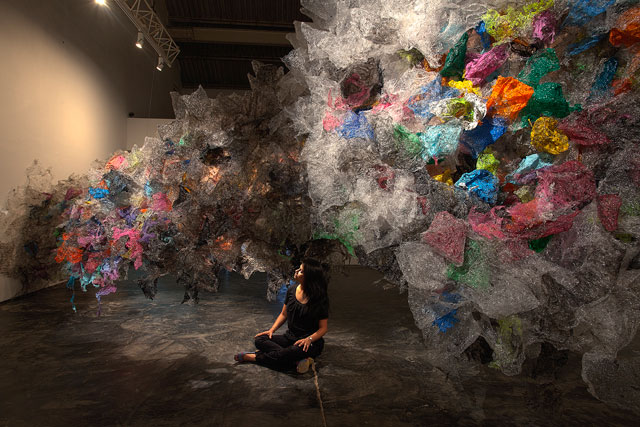
Aaditi Joshi. Untitled VII, 2011. Site-specific installation, fused plastic bags, acrylic paint, LED lights, wood armature, 432 x 94 x 110 in. Photo: David Desouza. Courtesy Gallery Maskara, Mumbai.
SAT: I guess your work takes quite a literal approach to a pressing contemporary issue that most turn a blind eye to, despite the overwhelming visual stimulus. (It always shocks me when people toss rubbish on to already existing piles of trash on the street.) I think the literal approach is quite useful because you are not turning the plastic into a metaphor, you lay it out for us instead. What do you want viewers to leave with after they have seen the work?
AJ: My work is my language of speaking about something I am thinking about all the time. Many people have concerns that I am using plastic as a material in my work; it is always the first question I am asked. When I am using plastic as an artwork, to me, something productive is coming out of my relationship with the material. By singling out the material in my work, it is interesting to see how people often forget that nearly everything we use in our daily lives is made from plastic. I want people to think about the aesthetic potential of plastic, of how it can be beautiful if treated in the correct way. I want them to look closely at the transformation processes and recognise the potential of the material. When someone collects my work, it is going to remain a precious object in their homes for hundreds of years. Their relationship to the material completely changes. I do not throw the plastic I use in my work in the trash, or in the sea; it is precious to me – and when I use it, I use it in a precious manner, as though it is as precious as a gem.
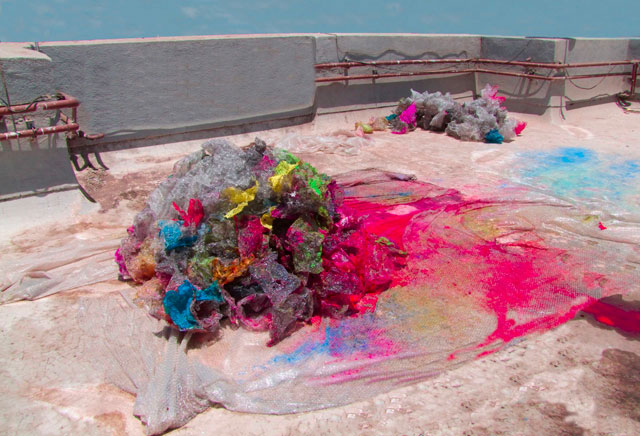
Aaditi Joshi. Untitled I, 2012-13. Digital print on Hahnemuhle paper (UltraChrome K3 inks), 40 x 58 in.
SAT: The series of photographs Untitled (I-IV) (2014) shows a near-invisible set of plastic bags and plastic bottles reflected on to a large glass window. It is a work with a light touch, very subtle: the plastic objects softly hover over the surrounding green lawn, ghost-like, a reminder that the material is constantly softly pressing on to our daily lives.
AJ: Yes, it is about the tension between the seen/unseen presence of plastic in our everyday life. The idea for it clicked quite spontaneously, and shows how I am always thinking about reflections and transparencies: I caught the reflection of a few objects in a large window and realised that the reflection was not only an image, but also a feeling. Transparency, to me, is always a feeling, even if it is in the transparency of a material. It invokes something very particular, something that is both invisible and visible at the same time. Transparency is also silent, and peaceful: the work is trying to show you the breeze in the air, the peaceful sounds of that green landscape.

Aaditi Joshi. Untitled V, 2011. Digital print on Hahnemuhle paper (UltraChrome K3 inks), 40 x 53.3 in.
SAT: I would love you to speak more about this “feeling”. What do you mean, exactly? Is your interest in transparency purely aesthetic? Or is there an inherent metaphor to it?
AJ: The building where I lived while growing up was right in the middle of a crowded vegetable and fruit market. Walking home from school, I would pass rows and rows of plastic-wrapped objects. To me, they looked so neat and beautiful, so well preserved. Perhaps that is where the interest comes from. Plastic is not “new” in any sense, it is something I grew up surrounded by, particularly living in a megacity like Mumbai. I grew up constantly handling plastic, and I continue to do so, although it is now in very different ways. I have tried to work with other mediums, but they have never worked out for me, I always to return to plastic. I am not fond of wood, I am not fond of printmaking, I am not interested in plaster or stone. I find that plastic is a very free medium, and that I can handle it in my own unique way. I can tear it, I can mould it, I can paint on it, I can see through it! These qualities keep bringing me back.